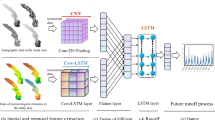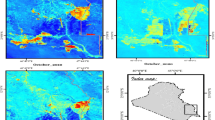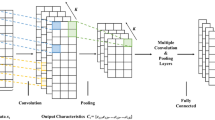Abstract
Runoff forecasting is extremely important for various activities of water pollution research and agricultural. Data-driven models have been proved an effective approach in predicting daily runoff when combining deep learning methods (DLM). However, predicting accuracy of daily runoff still need improved. Here, we firstly proposed a combined model of Gate Recurrent Unit (GRU) and Residual Network (ResNet) and compared with one shallow learning method (Back Propagation Neural Network, BPNN) and one deep learning method (GRU) with data from 2010 to 2020 in three stations in daily runoff forecasting in the Yiluo River watershed. The results showed that the combined model with precipitation data and runoff data as input has the highest prediction accuracy (NSE = 0.9325, 0.8735, 0.9186, respectively). Input data with precipitation have higher prediction accuracy than that without. The performance of the model was better in the dry season than the wet season. The topographic and geomorphic factors may also the main factors affecting runoff forecast. Those results of this study can provide useful strategies to predict short runoff and manage watershed scale water resources especially in the important agriculture region.










Similar content being viewed by others
Data availability
Data are available on request.
References
Apaydin H, Hajar F, Mohammad TS (2020) Comparative Analysis of Recurrent Neural Network Architectures for Reservoir Inflow Forecasting. Water 12(5). https://doi.org/10.3390/w12051500
Bi X, Li B, Lu W, Zhou X (2020) Daily runoff forecasting based on data-augmented neural network model. J Hydroinf 22(4):900–915. https://doi.org/10.2166/hydro.2020.017
Che Z, Purushotham S, Cho K, Sontag D, Liu Y (2018) Recurrent Neural Networks for Multivariate Time Series with Missing Values. Sci Rep 8. https://doi.org/10.1038/s41598-018-24271-9
Chen H, Wang W, Chau K (2021) Flood Control Operation of Reservoir Group Using Yin-Yang Firefly Algorithm. Water Resour Manag 35(15):5325–5345. https://doi.org/10.1007/s11269-021-03005-z
Chen F, Su Y, Wang Y (2016) A novel prediction approach for runoff based on hybrid HMM-SVM Model, 5th International Conference on Sustainable Energy and Environment Engineering (ICSEEE). AER-Advances in Engineering Research, Shenzhen, PEOPLES R CHINA,63:135-139
Chu H, Wu W, Wang QJ, Nathan R, Wei J (2020) An ANN-based emulation modelling framework for flood inundation modelling: Application, challenges and future directions. Environ Model Softw 124. https://doi.org/10.1016/j.envsoft.2019.104587
Ebtehaj I, Saad S, Lariyah MS (2021) Prediction of daily water level using new hybridized GS-GMDH and ANFIS-FCM models. Eng Appl Comput Fluid Mech 15(1):1343–1361. https://doi.org/10.1080/19942060.2021.1966837
Eldaw AK, Salas JD, Garcia LA (2003) Long-range forecasting of the Nile River flows using climatic forcing. J Appl Meteorol 42(7):890–904. https://doi.org/10.1175/1520-0450(2003)042%3c0890:Lfotnr%3e2.0.Co;2
Fu M, Fan T, Ding Z et al (2020) Deep Learning Data-Intelligence Model Based on Adjusted Forecasting Window Scale: Application in Daily Streamflow Simulation. Ieee Access 8:32632–32651. https://doi.org/10.1109/access.2020.2974406
Gao S, et al (2020) Short-term runoff prediction with GRU and LSTM networks without requiring time step optimization during sample generation. J Hydrol 589. https://doi.org/10.1016/j.jhydrol.2020.125188
Ha S, Liu D, Mu L (2021) Prediction of Yangtze River streamflow based on deep learning neural network with El Nino-Southern Oscillation. Sci Rep 11(1). https://doi.org/10.1038/s41598-021-90964-3
Han H, Morrison RR (2022) Data-driven approaches for runoff prediction using distributed data. Stoch Env Res Risk A 36(8):2153–2171. https://doi.org/10.1007/s00477-021-01993-3
He K, Zhang X, Ren S, Sun J (2016) Deep Residual Learning for Image Recognition. Microsoft Res, Beijing, Peoples R China: 770–778. https://doi.org/10.1109/cvpr.2016.90
Hu C, et al (2018) Deep Learning with a Long Short-Term Memory Networks Approach for Rainfall-Runoff Simulation. Water 10(11). https://doi.org/10.3390/w10111543
Jie L, Wensheng W, Yueqing LI, Weijun H (2006) Support Vector Machine Method and Its Application to Prediction of Runoff. J Sichuan Univ Eng Sci Edition 38(6):24–28
Kaya CM, Tayfur G, Gungor O (2019) Predicting flood plain inundation for natural channels having no upstream gauged stations. J Water Clim Chang 10(2):360–372. https://doi.org/10.2166/wcc.2017.307
Liang J, Li W, Bradford SA, Simunek J (2019) Physics-Informed Data-Driven Models to Predict Surface Runoff Water Quantity and Quality in Agricultural Fields. Water 11(2). https://doi.org/10.3390/w11020200
Liao Z, Pan P, Fan X, et al (2021) SIRVD-DL: A COVID-19 deep learning prediction model based on time-dependent SIRVD. Comput Biol Med 138. https://doi.org/10.1016/j.compbiomed.2021.104868
Liu W, Jing Z, Pan H et al (2020) Distance-directed Target Searching for a Deep Visual Servo SMA Driven Soft Robot Using Reinforcement Learning. J Bionic Eng 17(6):1126–1138. https://doi.org/10.1007/s42235-020-0102-8
Liu G, Ding Q, Luo H, et al (2022) Cx22: A new publicly available dataset for deep learning-based segmentation of cervical cytology images. Comput Biol Med 150. https://doi.org/10.1016/j.compbiomed.2022.106194
McInerney D, Thyer M, Kavetski D, Lerat J, Kuczera G (2017) Improving probabilistic prediction of daily streamflow by identifying Pareto optimal approaches for modeling heteroscedastic residual errors. Water Resour Res 53(3):2199–2239. https://doi.org/10.1002/2016wr019168
Napolitano G, See L, Calvo B, Savi F, Heppenstall A (2010) A conceptual and neural network model for real-time flood forecasting of the Tiber River in Rome. Phys Chem Earth 35(3–5):187–194. https://doi.org/10.1016/j.pce.2009.12.004
Roy B, et al (2021) Data-Driven Approach for Rainfall-Runoff Modelling Using Equilibrium Optimizer Coupled Extreme Learning Machine and Deep Neural Network. Appl Sci-Basel 11(13). https://doi.org/10.3390/app11136238
Samantaray S, Ghose DK (2019) Sediment assessment for a watershed in arid region via neural networks. Sadhana-Acad Proc Eng Sci 44(10). https://doi.org/10.1007/s12046-019-1199-5
Tan Q et al (2018) An adaptive middle and long-term runoff forecast model using EEMD-ANN hybrid approach. J Hydrol 567:767–780. https://doi.org/10.1016/j.jhydrol.2018.01.015
Taormina R, Chau K-W (2015) Data-driven input variable selection for rainfall-runoff modeling using binary-coded particle swarm optimization and Extreme Learning Machines. J Hydrol 529:1617–1632. https://doi.org/10.1016/j.jhydrol.2015.08.022
Thanh L, Ha KJ, Bae DH (2021) Projected response of global runoff to El Nino-Southern oscillation. Environ Res Lett 16(8). https://doi.org/10.1088/1748-9326/ac13ed
Toth E, Brath A, Montanari A (2000) Comparison of short-term rainfall prediction models for real-time flood forecasting. J Hydrol 239(1–4):132–147. https://doi.org/10.1016/s0022-1694(00)00344-9
Unnikrishnan P, Jothiprakash V (2020) Hybrid SSA-ARIMA-ANN Model for Forecasting Daily Rainfall. Water Resour Manag 34(11):3609–3623. https://doi.org/10.1007/s11269-020-02638-w
Wang Z et al (2005) Genetic Operators Affect on ANN of Runoff Forecast. Geomat Inform Sci Wuhan Univ 30(11):1020–1024
Wang Y, Guo S, Xiong L, Liu P, Liu D (2015) Daily Runoff Forecasting Model Based on ANN and Data Preprocessing Techniques. Water 7(8):4144–4160. https://doi.org/10.3390/w7084144
Wang X, Liu C, Hou H, Wang X (2021) Identifying watershed-scale spatiotemporal groundwater and surface water mixing function in the Yiluo River, Middle of China. Environ Sci Pollut Res 28(9):11053–11065. https://doi.org/10.1007/s11356-020-11285-y
Wang X, Jia S, Liu Z, Mao B (2022b) Watershed-Scale Shallow Groundwater Anthropogenic Nitrate Source, Loading, and Contamination Assessment in a Typical Wheat Production Region: Case Study in Yiluo River Watershed, Middle of China. Water 14:3979
Wang K, Band S, Ameri R et al (2022c) Performance improvement of machine learning models via wavelet theory in estimating monthly river streamflow. Eng Appl Comput Fluid Mech 16(1):1833–1848. https://doi.org/10.1080/19942060.2022.2119281
Wang X, Xu YJ, Liu Z, Jia S, Mao B (2023) Spatiotemporal changes of nitrate retention atthe interface between surface water and groundwater: Insightfrom watershed scale in an elevated nitrate region. Hydrol Process 37(3):e14856. https://doi.org/10.1002/hyp.1485612of12
Wang X, Xu YJ, Zhang L (2022a) Watershed scale spatiotemporal nitrogen transport and source tracing using dual isotopes among surface water, sediments and groundwater in the Yiluo River Watershed, Middle of China. Sci Total Environ 833. https://doi.org/10.1016/j.scitotenv.2022.155180
Won YM, Lee JH, Moon HT, Moon YI (2022) Development and Application of an Urban Flood Forecasting and Warning Process to Reduce Urban Flood Damage: A Case Study of Dorim River Basin, Seoul. Water 14(2). https://doi.org/10.3390/w14020187
Wu Z, Xuan S, Xie J, Lin C, Lu C (2022) How to ensure the confidentiality of electronic medical records on the cloud: A technical perspective. Comput Biol Med 147. https://doi.org/10.1016/j.compbiomed.2022.105726
Xiang Z, Yan J, Demir I (2020) A Rainfall-Runoff Model With LSTM-Based Sequence-to-Sequence Learning. Water Resour Res 56(1). https://doi.org/10.1029/2019wr025326
Xie T, et al (2019) Hybrid forecasting model for non-stationary daily runoff series: A case study in the Han River Basin, China. J Hydrol 577. https://doi.org/10.1016/j.jhydrol.2019.123915
Yin H, et al (2021) Rainfall-runoff modeling using LSTM-based multi-state-vector sequence-to-sequence model. J Hydrol 598. https://doi.org/10.1016/j.jhydrol.2021.126378
Yin H, et al (2022) Rainfall-runoff modeling using long short-term memory based step-sequence framework. J Hydrol 610. https://doi.org/10.1016/j.jhydrol.2022.127901
Zhang J, et al (2021) Daily runoff forecasting by deep recursive neural network. J Hydrol 596. https://doi.org/10.1016/j.jhydrol.2021.126067
Funding
This research was supported by the Fundamental Research Funds for the Central Universities (22120220348), the Natural Science Foundation of Hebei Province (D2018504002) and Overseas High-level Talents Program of Shanghai and Leading Talents (Overseas) Program of Shanghai.
Author information
Authors and Affiliations
Contributions
All authors contributed to the design and development of this manuscript. Shunqing Jia carried out the data collecting and analysis work, dealing data of this manuscript, writing the original draft preparation, Xihua Wang advising on the manuscript structuring and data analysis, as well as revising the manuscript and contributed to the conceptual integration and interpretation of the findings. Zejun Liu and Boyang Mao conducted the field samplings collection, data statistic dealing. All authors read and approved the final manuscript.
Corresponding author
Ethics declarations
Ethical approval
The study did not use any data which need approval.
Consent to participate
All authors participated in the process of draft completion. All authors have read and agreed to the published version of the manuscript.
Consent to publish
All authors agree to publish.
Competing interests
The authors declare no competing interests.
Additional information
Responsible Editor: Marcus Schulz
Publisher's note
Springer Nature remains neutral with regard to jurisdictional claims in published maps and institutional affiliations.
Rights and permissions
Springer Nature or its licensor (e.g. a society or other partner) holds exclusive rights to this article under a publishing agreement with the author(s) or other rightsholder(s); author self-archiving of the accepted manuscript version of this article is solely governed by the terms of such publishing agreement and applicable law.
About this article
Cite this article
Jia, S., Wang, X., Liu, Z. et al. Comparison of multi-DLM approaches for predicting daily runoff: evidence from the data-driven model in one of China’s largest wheat production-bases. Environ Sci Pollut Res 30, 93862–93876 (2023). https://doi.org/10.1007/s11356-023-29030-6
Received:
Accepted:
Published:
Issue Date:
DOI: https://doi.org/10.1007/s11356-023-29030-6




